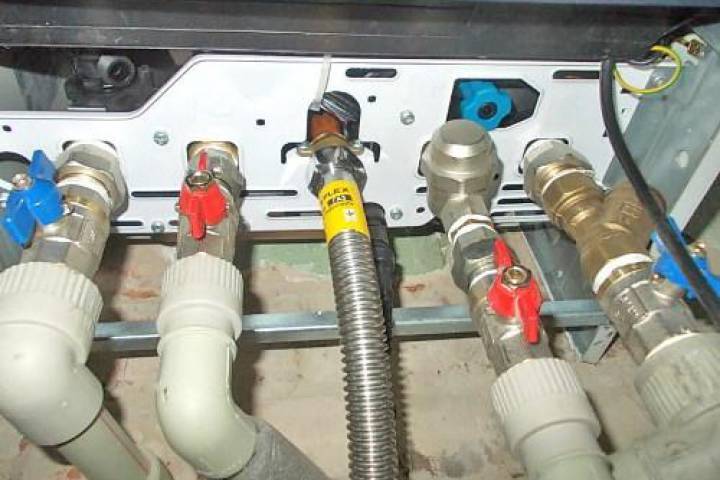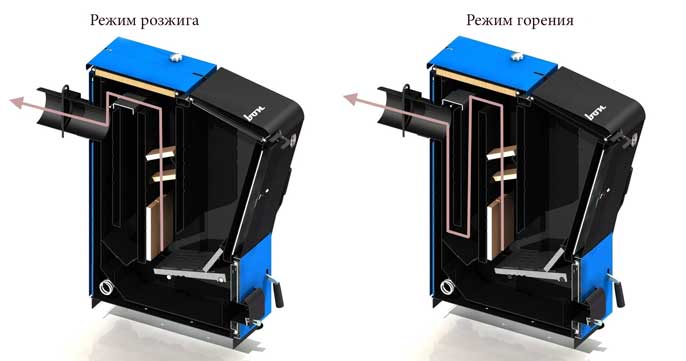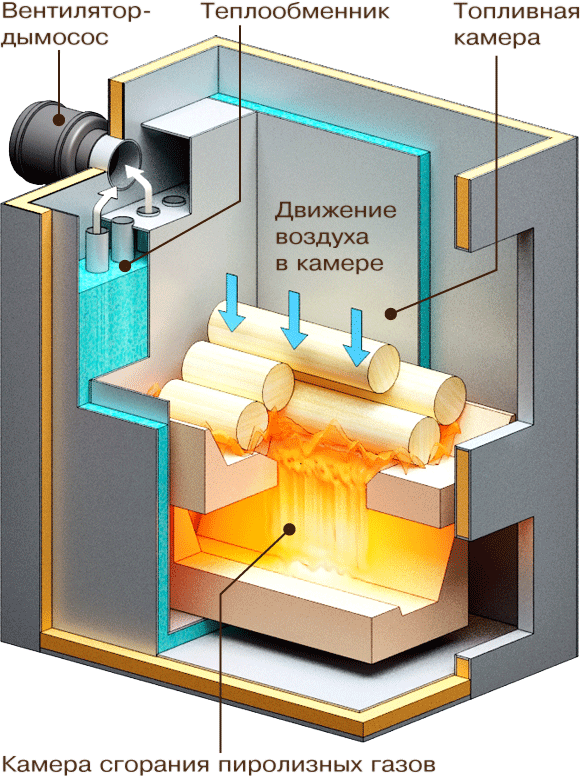The choice of a heating boiler can be made on the basis of many criteria. The type and price of the fuel used by the boiler for the home, as well as the cost of the unit itself, are very important. Also, to these selection criteria, you need to add design features, the principle of operation, efficiency, technical capabilities, ease of use, ease of installation. However, first of all, you need to find out what are and what are the individual types of boilers.
Kinds
Modern boilers for a private house are classified according to the type of fuel. On this basis, they are:
- . They give heat by burning both natural and liquefied gas. True, in order to switch from one type of gas to another, it is necessary to correctly install a special kit and reconfigure the household appliance.
- . In them, heat is generated by burning all types of coal, firewood, briquettes, pellets. Many models are designed to burn some types of solid fuels. The most versatile are coal. They can burn any fuel. True, the choice of another heat source turns into an increased need for fuel, since the walls of the furnace are very thick.
- . They run on diesel fuel, gasoline or waste oil.
- . These boilers for country houses or cottages are universal because they are able to use various types of fuel to heat a private one-story house. Some of them are designed in such a way that they can heat the coolant using all the main heat sources.
gas boilers
Such modern boilers for the home are:
- Wall mounted. These gas units are compact in size, low power(it is enough for heating houses with an area of up to 280 sq. M), good automation and built-in nodes that are necessary for organizing the strapping. They can be installed in the kitchen.
- Outdoor. These gas devices are designed for houses with medium and large areas. Their power often exceeds 50 kW. Due to their high thermal performance, they are large and heavy. If they are chosen, it is necessary to create a boiler room.

According to the principle of operation, gas devices for giving are:
- Traditional. Heating of the coolant occurs solely due to the heat that is released during the combustion of gas. Such wall-mounted boilers are afraid of water that cools below 60 ° C. This is because it causes condensate to settle on the heat exchanger. And along with it, acids also settle, which corrode the walls of the heat exchanger. Therefore, traditional gas boilers are not suitable for water floors.
- Condensation. Such boilers transfer to antifreeze not only the heat that is released during the combustion of gas, but also the heat that vapors formed from water contain (in any gas there is a small amount of water). Thanks to this principle of operation, their efficiency is 7-10% higher compared to that of the above-mentioned boiler. For their operation, it is correct to create conditions under which the return water will be colder than 57 ° C. The only downside is that such economical gas installations are very expensive.
By the number of circuits, boilers are:
- Single-loop. Designed for heating only heating systems. If you need to organize hot water supply, without which modern life is impossible, you must use.
- Double-circuit. They heat water both for the heating system and for domestic hot water. They are a good choice for small homes with few hot water outlets. This is because as such points increase, colder water flows from the faucet.
Double-circuit boilers with a storage tank or a layered heating boiler do not have such disadvantages. It is worth adding that classic double-circuit devices can operate either in the heating mode of a country one-story house, or in the hot water mode.
Another thing to consider when choosing gas boilers is what kind of combustion chambers are. They are:
- open. In such installations, fresh air is taken from the room, and carbon monoxide exits through a classic chimney.
- closed. Air comes from outside. It moves through a coaxial chimney. Carbon monoxide is expelled through the same chimney.
The best among gas units is for a cottage.
Solid fuel boilers
A feature of all modern solid fuel boilers are large sizes. For this reason, there are no wall-mounted options. There are only outdoor. Most models are equipped with two circuits. In this case, both circuits work simultaneously, and not in turn, as in the situation with gas boilers.

Today you can choose such solid fuel heating boilers for summer cottages:
- Direct combustion units. They are have the simplest design and therefore are the cheapest. The fuel in them burns from the bottom up. Air to maintain the fire enters through the ash chamber and the grate placed above it. The disadvantages include: rapid combustion of fuel, and it does not burn out completely; low efficiency - up to 78%; the need for the constant presence of people; lack of electrical automation (some of the models still have it). True, this minus makes the floor boiler in the house non-volatile.
- Boilers of long burning. They differ in that fuel burns from top to bottom. In fact, any type of fuel placed in the furnace does not burn, but smolders, releasing the required amount of heat. Some floor models are designed so that one bookmark of firewood burns up to 30 hours, and up to 5 days. True, it is necessary to use fuel with a low percentage of moisture (no more than 20%). Among these boilers there are models that partially use the principle of pyrolysis. Therefore, their efficiency reaches 85-90%. These are floor units "Stropuva" and their analogues.
- pyrolysis boilers. They can be called a variety of the above boilers. The fuel in them also burns for a long time, but they have a completely different principle of operation. Within these units wood, coal or briquettes decompose into gases and solid particles. The first are fed into a special chamber, where they are burned. Actually 90% of the heat supplied to the heating system is released during the combustion of gas.
This type of solid fuel is the most economical and efficient among all modern household appliances, since the efficiency exceeds 90%. True, this applies to floor-standing boilers with a smoke exhauster. Devices with a fan have an efficiency of no more than 84%. All of them have a complex structure, which is why they are expensive. But, despite this, many owners want to choose them.

- Boilers of ultra-long burning. In them. Many of them are .
- They are very different from all solid fuels, because they have a special burner for burning pellets. They do not have large fireboxes. Such floor-standing boilers for a summer residence or a one-story house are always supplemented with an auger and a hopper for loading pellets. The latter is of such dimensions that fuel loading must be carried out once a month.
Pellet boilers can be called the best in terms of ease of use when compared with other types of solid fuel boilers. Cons: high cost, high quality pellets, constant need for electricity, the need for a UPS capable of delivering current with ideal characteristics.
Electrical devices
Any modern electric boiler for a summer residence or a one-story house is distinguished by the fact that it is:
- Inexpensive.
- Convenient to use.
- Compact. Therefore, most of his models are wall-mounted.
- Easy to install.
- Highly efficient. The efficiency is 100%.
True, due to the considerable cost of electricity, such boilers for country houses or cottages create a considerable burden on the pocket.

Their choice is represented by the following types:
- wall. The heating of the house is due to the work of several heating elements. Heating is controlled by connecting / disconnecting one heating element or a group of heating elements. This can be done either manually or automatically. It is better to choose the second option, since the automation itself determines which heaters need to be turned on or off. At the same time, it always takes into account what the temperature of the coolant should be.
Wall-mounted heating elements for country houses can work with any type of coolant. However, they do not like hard water, since scale on the heating element weakens the heating of the coolant, which causes the heating element to overheat and disable it ahead of time;
— . Such wall-mounted devices for country cottages heat the coolant in a different way. The essence of their work is to pass an electric current through the water. To do this, the electrodes are simply placed in a container of water. For current to flow, there must be salt particles in the water. Passing current through water causes it to heat up. Moreover, it heats up instantly, and not after a few seconds, as inside wall-mounted boilers with heating elements.
The low inertia of the system and automation allow reduce home heating costs by 20%, if we compare them with a similar amount created by the heating element. True, in such wall-mounted boilers for a country house there should be only water with the right concentration of salts. Other coolants cannot be used. Also, the electrodes need to be replaced from time to time;
— . Such household units have an induction coil. When a current passes through it, eddy currents arise between its turns. They also heat the walls of the tank with water. The heat is then transferred to the water. The coil itself is located around the container with water or inside it. In the second case, it is isolated from water.
Each induction boiler for a private house has the largest dimensions among electric heaters. In addition, it is the most expensive. But people choose it for a very long service life, the ability to work with any coolant and the independence of work from scale.
All electric boilers are single-circuit and double-circuit. The latter, as well as gas double-circuit installations, operate either in the mode of heating water for the heating system of a country house, or in the DHW mode.
liquid fuel unit
For heating a summer house, it is very similar to a gas device. The only difference is the special burner. She is always inflatable. That is, diesel fuel or gasoline is fed into the furnace under pressure. Of course, in the burner they are mixed with air and when they enter the furnace, they immediately burn out.








